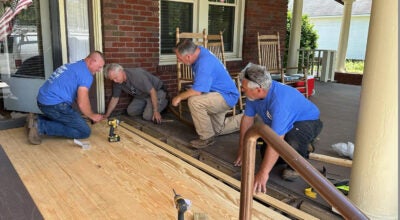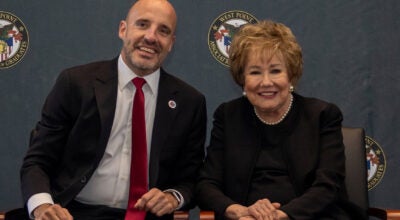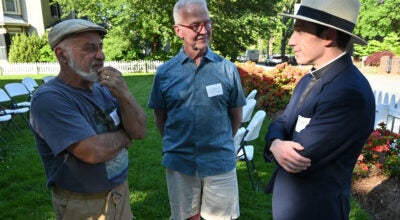Wineka column: Captured flag connects family to Pearl Harbor
Published 12:00 am Wednesday, December 7, 2011
SALISBURY — When Robert D. Hartman spoke of it years later to his family, he described a scene of U.S. sailors — the “prize crew” — running through all parts of the Japanese battleship Nagato and collecting souvenirs.
Hartman secured a large Japanese flag from the battleship. He also loaded himself down with Japanese handguns, rifles and binoculars — things he sold or gave away years later.
“Everybody ran on that ship and took what they wanted,” says the late Hartman’s oldest daughter, Dianne Hall, who lives on High Rock Lake in Rowan County.
The end-of-World-War-II story is significant for several reasons, especially on the 70th anniversary of the Japanese bombing of Pearl Harbor.
The Nagato was the flagship of Admiral Isoroku Yamaoto, and it was from the Nagato’s bridge that he heard his planned attack on Pearl Harbor had been launched.
Dec. 7, 1941, was, in President Franklin D. Roosevelt’s words, a day that would live in infamy, and it signaled America’s entrance into World War II.
Less than four years later, on Aug. 30, 1945, a 20-year-old Hartman was serving on the USS Horace A. Bass when it pulled up alongside the Nagato in Tokyo Bay. He and others boarded her, effectively becoming the first crew to capture a Japanese battleship afloat in World War II.
Sixteen Japanese officers received the boarding party and turned over the battleship in a ceremony that took no more than 10 minutes.
The USS Horace A. Bass — a high-speed destroyer and transport — met no resistance because the atomic bombs already had been dropped on Hiroshima and Nagasaki. Any fight the Japanese had left disappeared with those attacks and Emperor Hirohito’s announced surrender Aug. 15, 1945. (The formal surrender would come Sept. 2.)
Still, it was necessary for the Bass to take over the battleship, which had eight 16-inch guns and was anchored at the mouth of Tokyo Bay, directly in the path of the incoming U.S. forces.
“They didn’t know what was going on, but they knew they had to get that ship,” Hall says of her father’s crew.
The USS San Diego, a cruiser generally regarded by history as the first Allied warship to enter Tokyo Bay at war’s end, came in a full hour later. Crew members of the Bass liked to claim it was the Bass that led the San Diego into the Japanese Navy Yard’s main docks.
Later in the day, the Bass received a radio message from Fleet Admiral William F. “Bull” Halsey congratulating the crew on a job well done.
The Nagato was the Japanese Imperial Navy’s last remaining battleship.
• • •
As a 6-year-old stationed with her parents at Fort Huachuca, Ariz., Dianne Hall remembers being cold one day and reaching for folded material she thought was a blanket.
Heavy and woolen, it soon became unbearable because it was so itchy.
The little girl had no idea her blanket was one of the red-and-white battle flags from the Nagato.
Years later, after Dianne had long learned the significance of the flag, she asked her father whether she could use it as part of the military, red-white-and-blue theme she had established for her son’s bedroom.
“It covered his whole wall,” she recalls.
But Hartman soon wanted the historic flag back, so he could hang it in the basement of his home in Reidsville. It was during a time when he was working at the Miller Brewing plant.
His basement served as a game room, and the grandchildren sometimes used the large Japanese flag as a dart board.
The flag passed on to Dianne at Hartman’s death in July 1999.
“He was proud of what he did,” Dianne said of her father’s distinguished military career, which included his 28 months in the Pacific theater during World War II, then a separate career in the U.S. Army that also took in Korea before he retired in 1967.
He followed his stints in the military with years at Pfeiffer College, the Hoechst Celanese plant in Salisbury and the Miller Brewing operation in Eden.
• • •
A native of Rowan County, Hartman enlisted in the Navy in January 1943 and built his reputation in both the Navy and Army as a cook.
“He was very, very good,” says daughter Betty Jo Eller.
The family still talks about his way with chop suey, oyster stew, Thanksgiving dressing and prime rib roast with brown gravy.
Hartman sometimes spoke of the close call he had on the USS Horace A. Bass.
The high-speed transport, commissioned in late 1944, sailed westward from San Diego in March 1945 for the concluding portion of World War II in the Pacific.
The transport stopped at Pearl Harbor, Eniwetok and Ulithi before arriving at Okinawa and the last major amphibious strike by U.S. forces against the Japanese.
The Bass earned credit for shooting down one plane during its initial “picket duty” at Okinawa. It later sailed with a convoy to Guam and, on its return, sank a Japanese submarine with a depth charge.
The Bass resumed its picket duty at Okinawa, combined with convoy missions to Guam and Saipan. By mid-June, though Okinawa was secured, the U.S. ships remained under air attacks. The Bass had to provide anti-aircraft and anti-submarine protection to other ships off Okinawa.
Hartman’s close call came July 30, 1945, when a kamikaze fighter crashed into the transport while it was on picket duty. The suicide bomber hit where Hartman usually would have been sleeping, except this time he was elsewhere on the ship playing cards.
The Bass suffered 14 casualties from the kamikaze, including one fatality close to where Hartman should have been sleeping. The transport was repaired quickly and set off north toward Japan and Tokyo Bay by Aug. 14, taking part in the eventual occupation of the Yokosuka Naval Base.
• • •
After the war and before enlisting in the Army, Hartman worked in cotton mills and for the Stanback Co. in Salisbury. He married the former Joyce Crowell in 1949, and the couple’s five children include Dianne, Betty Jo, Sherry, Robert Jr. and Wanda. The family followed Hartman to Army bases across the United States and to Japan and Germany.
“Military brats are really something, I’ll tell you,” says Dianne, who has always wanted to write a book about her childhood experiences at the various Army bases. “… You wouldn’t believe the trips we had — that’s the way my father was, go, go, go.”
Dianne’s traveling days ended when her father retired from the Army in 1967 and went to work as a cook at Pfeiffer College. She attended her senior year in high school at North Stanly.
Throughout his life, Hartman held a keen interest in World War II history. Before he died, Rowan Public Library recorded an oral history with him as one of the local veterans of World War II. That tape remains at the library.
He always spoke of his fellow sailors as brothers, Dianne says, and he especially delighted in their chances to go on shore on leave.
Dianne has been debating what to do with the Japanese flag from the Nagato. She thinks she will lend it to the Price of Freedom Museum, located in the old Patterson School off Weaver Road.
The museum is filled with military uniforms, artifacts and memorabilia contributed by local families.
“I’d rather put it somewhere here, in honor of Daddy,” Dianne says.
What happened to the Nagato?
In 1946, the 700-foot-long, 42,850-ton battleship was towed to Bikini Atoll to serve as a target for a series of nuclear weapon tests. In the first test, it was not severely damaged.
But the weapons hit the Nagato hard in a second test July 25, 1946, leading to its sinking five days later. It is now considered one of the world’s top wreck diving sites.
Contact Mark Wineka at 704-797-4263 or mwineka@salisburypost.com




